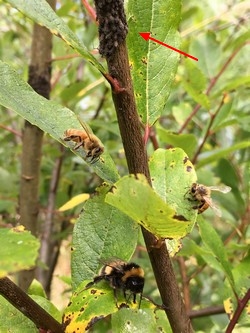The Programme
Note: This programme completed in 2022
The giant willow aphid (Tuberolachnus salignus) was first discovered in New Zealand in 2013. The aphid attacks, damages, and can eventually kill willow trees. Willows are important for stabilisation of river banks and sloped land, and willow flowers are an important food source for honey bees in early spring.
The aphids feed on willow sap and release copious amounts of sugary honeydew that is readily gathered by bees (see image). Complex sugars in the honeydew crystalise in the honeycomb, making extraction very difficult. The honeydew is also an attractive food source for pest wasps. Black sooty mould grows on honeydew coated surfaces, causing a number of other negative impacts across a range of sectors, including parks, gardens, horticultural and agricultural products.
The aim of this programme is long term control of giant willow aphid using sustainable methods that pose little or no risk to other organisms or the environment. Scion is targeting a biological control agent to be imported and tested for safety prior to release in New Zealand. Plant & Food Research is looking at the impact of the giant willow aphid on willow health.

